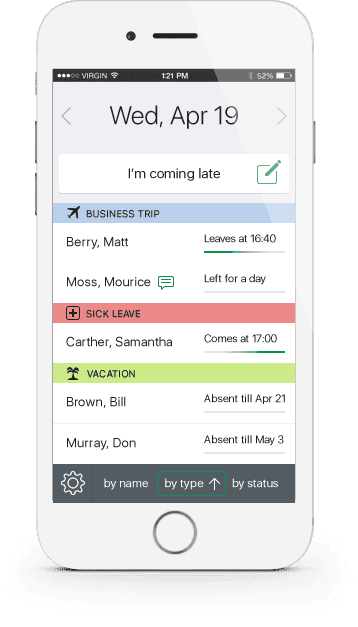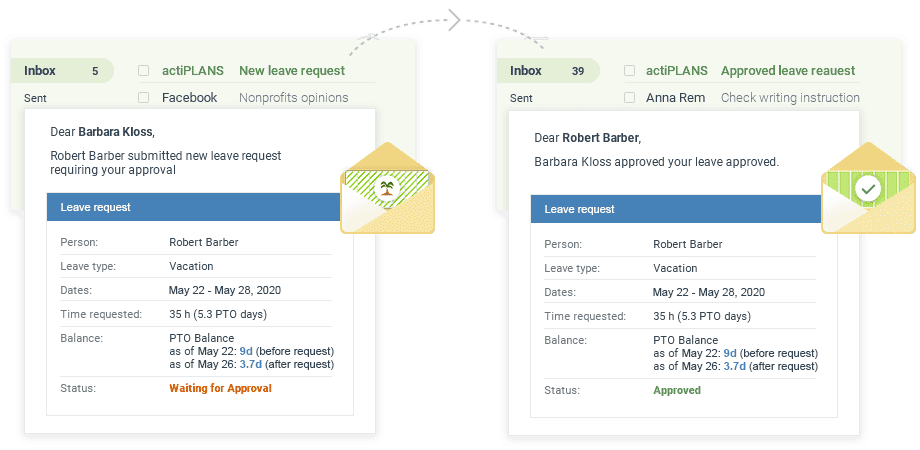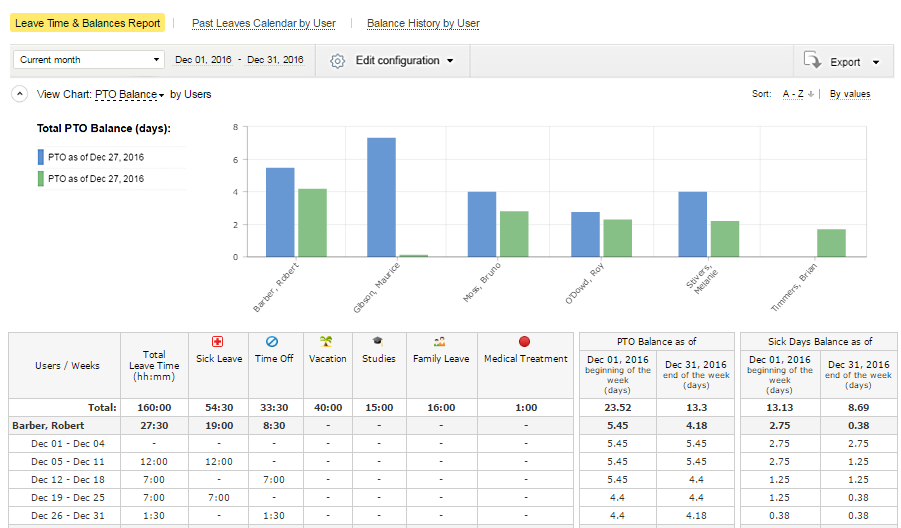We all know the importance of a well-rounded work-life balance, so why not make it a reality in your company by introducing flexible time off?
By building flexibility into a company’s leave policies, you can ensure all your team members’ needs are met without compromising the quality of the job done. Now let’s explore what makes up a good flexible time off policy, the advantages of creating one, and the pitfalls you may encounter on the way.
What Is Flexible Time Off?
Flexible time off, also known as open PTO, is a policy that allows employees to take time off as needed for any reason without worrying about accruing vacation time.
Unlike traditional vacation policies, flexible time off does not always require employees to request time off in advance. This policy gives employees the freedom to take time off for any personal reasons, family events, medical appointments, or simply to recharge.
One emerging trend in flexible time off policies is the use of “unlimited” time off policies, which have become popular in recent years. These policies allow employees to take as much time off as they need, as long as they get their work done.
While these policies can be beneficial for employee morale and retention, they can also be difficult to manage and may lead to abuse or inequities in how time off is distributed. As a result, some companies are now implementing more structured and nuanced policies that balance employee flexibility with the need for clear guidelines and accountability.
Useful Statistics on Workplace Flexibility and Time Off
- With flexible work schedules, only 14% of employees show signs of burnout as compared to 36% of employees in traditional workplace arrangements.
- 83% of employees in companies that offer some flexibility perceive their workplace culture as positive in contrast to 47% of employees in workplaces with no flexibility (Source).
- Taking days off helps to lower job-related stress by 65% (Source).
- While almost 90% of US employees reported experiencing burnout in 2022, only 46% of them actually used all their earned PTO (Source).
- The number of times employees mentioned unlimited PTO in online workplace reviews has increased by 75% from the pre-pandemic years, and most of these reviews were positive (Source).
Benefits of Flexible Time Off for Employees
Flexibility is the spice of life, and when it comes to time off, things become even more exciting. Here are the top 5 positive effects of flexible time off on employees’ lives:
- Reduced risk of burnout: Have you ever felt like a burnt piece of toast? With flexible time off, you never have to feel that way again. You can take time off when you need to, without worrying about the burnout that comes with working too much.
- Better work-life balance: Flexible time off means you get to have a life outside of work (gasp!). You can be the most hard-working employee during your working hours and still have ample time to pursue your hobbies, spend time with your family, and catch up on your favorite Netflix shows.
- Improved mental health: Let’s be real, adulting is hard. We all need a break sometimes, and flexible time off makes it easier to take that break. Whether you need to stay home for a day or take a trip to decompress, flexible time off makes you feel better and benefits your mental health in the long run.
- Increased job satisfaction: It feels great to work at a company where employees are trusted and have the autonomy to decide when to work. Having the ability to choose when you take time off gives you more control of your life, therefore increasing job satisfaction.
Benefits of Flexible Time Off for Employers
Flexible leave policies have many benefits for employers as well. For example, the software company HubSpot implemented a flexible vacation policy in which employees can take as much time off as they need as long as they get their work done. This has led to higher employee satisfaction, lower turnover rates, and increased productivity.
Here are the key proven benefits of flexible time off your business can gain as well:
- Stronger ability to attract top talent: In this day and age, employees aren’t just looking for jobs to pay the bills – they’re looking for work that aligns with their values and priorities. And one of their top priorities? You guessed it, work-life balance (which is where flexible time off comes into play). So, if you want to attract and retain top talent, offering flexible time off is a must.
- Better company culture: When companies offer flexible time off, it shows that they care about their employees’ well-being. This type of employee-centric approach enhances company culture and fosters a positive work environment.
- Increased employee loyalty: Studies show that employees who feel valued and supported by their employer are more likely to stay with that company in the long term. Flexible time off is an excellent way to show your employees that you care about them and their needs, and this motivates them to stick around for the long haul.
- Productivity boost: What’s better than a happy employee? A happy employee who’s also productive. When employees have the freedom to take time off when they need it, they’re more likely to come back to work refreshed and ready to get stuff done.
Main Pitfalls of Flexible Time Off
While flexible time off policies can have many benefits, there are also potential downsides that companies need to consider:
- Abuse of policy: One of the main concerns about flexible time off policies is that employees may abuse the system by taking excessive amounts of time off, which can negatively impact productivity and the overall functioning of the company.
- Counterproductive results: You may tout the unlimited PTO perk to potential hires but if your company culture actually discourages employees from taking time off, they may start to feel like they’ve been deceived.
- Lack of coverage: Another downside is that it can be difficult to ensure adequate coverage in the workplace when employees are taking time off on an ad hoc basis. This can lead to issues with meeting deadlines, completing projects, and maintaining quality standards.
- Unequal distribution: There is also a risk that some employees may take more time off than others, leading to feelings of resentment and inequality among team members. This can be particularly problematic if some employees have more seniority or are in positions of power within the company.
- Burnout: While flexible time off policies are meant to promote work-life balance and reduce burnout, there is also a risk that employees may feel pressure to take less time off in order to meet performance expectations or to avoid falling behind on their work.
- Legal issues: Companies must also be aware of legal issues that may arise from flexible time off policies, such as compliance with labor laws and regulations around overtime pay, which can vary from country to country.
- Isn’t a cure-all: Flexible time off is no magic pill to fix all productivity and burnout issues you may have in your workplace. More comprehensive changes are often needed to create a healthy work environment.
It’s important for companies to consider these potential downsides when implementing flexible time off policies and to take steps to mitigate them through clear policies, effective communication, and appropriate training for managers and employees.
Besides, you need to realize that flexible time off is not suitable for every type of occupation and industry. For instance, a software developer may thrive thanks to greater flexibility but you can’t allow a hospital nurse to go absent whenever they want.
How to Create a Perfect Flexible Time Off Policy
Step 1: Define “flexible”
Before we dive head-first into the policy, we need to define what “flexible” means for your company. Does it refer to unlimited vacation? A set amount of paid time off with the option to work remotely? A hybrid of the two? Think of an arrangement that can perfectly fit your specific company culture and needs.
Step 2: Set expectations
At this step, you need to define your time off management rules:
- How much time off is too much?
- How often can employees take time off?
- How far in advance must they request it?
These are merely a few important questions to consider. Just remember, if your policy is too rigid, it defeats the purpose of being flexible in the first place.
Step 3: Create a system
To avoid any confusion or frustration, a clear and concise system for requesting and approving time off is crucial. This can be done through an online portal or a good old-fashioned paper form, but make sure it’s easily accessible and understandable for all employees.
Pro tip:
actiPLANS is the holy grail of flexible time off management. With its help, you will forget the pain of manually tracking time and leave requests – our user-friendly and intuitive solution saves both employees and managers from hours of needless spreadsheet wrangling.

actiPLANS offers easy self-scheduling features for employees, because who wants to deal with the headache of constantly coordinating vacation time with their boss? As an employee, you can request time off in a few clicks and see your team’s schedule at the same time. It’s like having your own personal vacation planner right at your fingertips.

And speaking of fingertips, actiPLANS Mobile makes it incredibly easy to request time off and inform your colleagues of tardiness or any other changes in your work schedule – no matter where you are. You don’t have to wait in line at the HR office or send countless emails back and forth. Just log in to the app, select your dates, and voila! Request sent.

But the advantages don’t stop there.
We’re talking automated notifications and leave request approvals. No more wondering if your boss received your request and is sitting on it for weeks on end. With actiPLANS, you’ll receive instant notifications and your leave will be approved or denied faster than you can say “I need a break.”
Check out actiPLANS in action during a free 30-day trial 👈
Step 4: Communicate!
Once the policy is in place, it’s important to communicate it effectively to all employees. Make sure they understand their options and how to use the system. You don’t want anyone feeling left out or confused. And don’t forget to remind them that productivity and results are still a top priority!
Step 5: Monitor and revise
Lastly, make sure to monitor and revise the policy as needed. Are there any patterns in time off requests that could be addressed? Did something unforeseen come up that needs to be added to the policy? Flexibility is all about being adaptable, so don’t be afraid to make changes as needed.
Pro tip:
who wants to sift through spreadsheets and charts all day? Not us, that’s for sure. That’s why actiPLANS makes it easy for you to get the information you need in a snap.
It features time off reports that allow you to dive headfirst into the nitty-gritty of your employees’ time off usage, giving you a clear picture of whether or not that flexible time off policy you put in place is actually working. And if it’s not – no worries! You can use that data to make adjustments and keep your team on track.

Summary
Flexible time off policies are becoming increasingly popular in the modern workplace. By offering this type of policy, employers can attract and retain top talent, promote a healthy work-life balance, and improve team morale and productivity.
Technology can play a key role in managing flexible time off policies. Consider using leave management software like actiPLANS to automate tracking and reporting, ensure compliance with labor laws, and reduce administrative burdens for HR managers. This can help ensure that policies are implemented effectively and efficiently and that employees can take the time off they need without causing an undue burden on the company.



